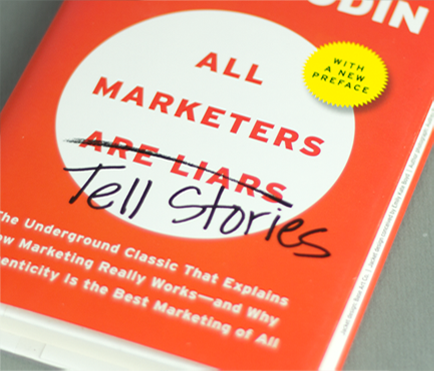All Designers are Liars
Wait, hold on.
Before you come after me for being intentionally provocative with my title, and before you jump to explain that you specifically are not a liar (“not all designers!”), let me explain what I’m talking about.
My title is a reference to Seth Godin’s book, All Marketers are Liars.
Seth doesn’t mean to say that all marketing people are actually liars; what he says is, one, that marketers are storytellers, and two, that these stories have to be interesting, different and memorable for someone to even listen to them. (Had the book been named All Marketers are Storytellers it would probably be far less appealing and, as a result, far less popular.)
My intention in this post is to explain why I think all designers are actually marketers, i.e. liars, i.e. storytellers.
If you’re anything like me, or at least like me from a while ago, you’re probably now saying to yourself:
“Well I’m really no marketer. I’m not one of those detestable people who wear suits and shake hands and knock on people’s doors trying to sell, sell, sell. Yuck! I’m a designer. My work sells itself.”
And that’s wrong.
Super wrong.
As designers, we have so much marketing work to do that I’m almost tempted to tell you that we have to know marketing better than marketers do.
Before we even have clients, we need marketing for them to be able to find us; during the work we need to market our vision to the client; and of course, the work itself – the design – is also a marketing element: the website has to sell, the brand has to sell, the app needs to sell, and obviously the ad needs to sell.
So now that we’re on the same page, agreeing we all work in marketing even though we’ve never studied it, let’s see what we need to know about it.
Here is how to market yourself.
Marketing before doing any work
By ‘marketing before work’ I mean: what is the marketing work that we have to do to get clients to find us – and also to convince them they want to work with us?
Whenever I see a Facebook banner offering a marketing class for designers, I imagine the course is about building Facebook pages, or promoting websites.
But honestly, I haven’t met a single designer who gets clients from having a nice-looking Facebook page.
90% or more of the projects designers get are from word of mouth: from someone who got a recommendation from a former client of yours, or through a friend or family member.
Nothing beats a great recommendation from someone your trust, and I don’t know a single person looking for a designer / developer / architect / mover / barber / psychologist without first asking the people they know whether said professional is trustworthy.
That is to say – of course a website and a Facebook page are important, but only as stage two. No one will arrive at them independently (or through a Facebook sponsored post) and just decide to work with you. They might get a recommendation and then check out your page – but not the other way around.
In that case, what can we do to make sure we get more excited clients with positive recommendations? The answer is relatively simple: increase the amount of people that know and trust us and would happily vouch for us.
I’m not going to tell you to go to conventions and do some networking, simply because I myself don’t do it. I’m bad at it and it embarasses me.
Some people do it and it works for them. You need to find out what you’re comfortable with and your own way that you can enjoy.
Here are some things that I like to do:
I take part in hackathons. I do it because it’s fun and because there’s always beer and free food. As a byproduct I also get to meet a ton of people from the startup world and spend an evening or a weekend with them, at the end of which they know me, like me, and even think I’m a pretty darn good designer.
I connect with the rest of my client’s team. Even though I usually work with one specific person, I do enjoy meeting and getting to know the other people in the office, whether they are developers or accountants. The byproduct here is that they might remember me when they, or someone they know, need a designer.
I write a blog. I’m not writing posts only because I’m hoping to score more work. Still, a major byproduct of writing it is that people who read it are gradually learning to trust and know me.
None of these things are direct marketing actions, but they all have marketing results.
There’s no one way or one trick or tip that works for everyone. You have to learn for yourself what you find comfortable, but keep in mind the result you’re after: to keep growing the circle of people who know, like and trust you, and who can recommend you when such services are needed.
The second step after a recommendation is probably a Google search.
At this point you do need to have a website / Linkedin profile in order to impress the potential client. I don’t have anything to add here that you don’t already know: if your website looks bad / cheap / doesn’t even exist, that’s going to be the impression you make on the client too.
Marketing during work
The nice thing about being an employee in a design studio is that you can design as you like, and the creative director is the one who has to try and sell your work to the client. That part doesn’t concern you.
But wait – did you just realize what the difference is between you and your manager? You can design, and they can probably design too; but more importantly, they can also sell.
Too many designers, some of them super talented, remain throughout their career at the bottom of the design world’s pyramid for the simple reason that they don’t know – and what’s worse, don’t want to learn – how to sell their work.
If you think that the most challenging thing about being a designer is sitting in an office listening to cool music and trying to solve your current brief, I’m sorry to have to tell you this but you’ve been lied to.
The true challenge is sitting across from a person who knows absolutely nothing about design, showing them your gorgeous work and trying to sell them the idea and why it’s the right one for them.
Our real job has two parts: first, to allay the client’s fears (and their panic that a bad logo will ruin their business), and second, to sell them our solution.
Here are some pointers to help you deal with this challenge:
Come prepared. Do your homework. Get to know the client deeply, get to know their competitors, get to know the market. Know to bring up examples from the rest of the world that support the direction you’re going for. Have a good answer for everything. Be able to explain even the things you did intuitively. Know how to explain exactly why you chose that font over others.
Create an amazing presentation. When I was studying at Design School, they used to make us hang our work straight up, print it on cardboard and all sorts of crap because otherwise “when you present it to the client they can tell it’s not perfect and it will hurt the work.”
Well, truthfully, ever since my graduation I never once presented anything on any wall.
99% of the time I present work on a computer, with an overhead projector or on a television screen. But the point is still relevant – create an amazing, meticulously made presentation which takes the client step by step towards your solution, and it will help you immensely in selling the idea to the client.
Once the client sees how much work you’ve put in the presentation, they will learn from it just how much work you’ve put in the design itself.
Be adorable. Yep, that’s right. If the client loves you, it will be easier for them to buy what you’re selling.
Don’t confuse being nice and friendly with slaving around and doing everything they ask. That’s not what I’m talking about. But be friendly. Engage in smalltalk. Be human. Even your mighty client might lose sleep because their son is teething.
The design itself as a marketing element
Oh, the bitter truth. We work in a profession that convinces people to do things. Usually to buy things. When Tyler Durden says “advertising has us chasing cars and clothes, working jobs we hate so we can buy shit we don’t need,” he probably means us too.
But let’s not be too gloomy about it. Let’s think about it this way: we’re convincing people to do things that are good for them, and helping to create a better world. Hurrah!
Either way, you have to know how to do it – and that, my friends, is marketing.
You’re designing a book cover so that someone will pick it up from the shelf and buy it. You’re designing a website so that someone will create an account…. and then buy something. You’re designing a menu so that someone will buy a dish. You’re designing an app – eventually someone is meant to buy something.
In order for us to create a good design which fills its purpose – i.e. convinced the user to do what we want them to do – we have to base our work on a lot of knowledge from other fields: psychology, economics, business and history are only some of the topics that will help us know how to do better work which will, in turn, sell better.
Want to be better designers and marketers? Start broadening your horizons.

Ran is the designer, head of product and co-founder at Bold & Creative. He's also a mentor at the Designer's Pricing Class.'
Super!
Good stuff is on the way.
Oops! Something went wrong while submitting the form :(



